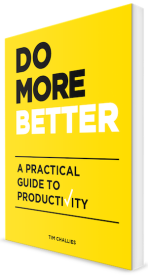Why We Need To See Our Email More Like Our Post


So, here’s a question: How do you feel about email?
Ping. “You have one new message.” And the reaction for many of us might be: Argggh!
Are you someone constantly attached to your inbox, checking it every five minutes?
Maybe you have notifications on your phone alerting you to every new email that comes in?
Or is your inbox such a great big heaving mess that you daren’t go near it, resigned to chaos and disorder.
Of course, such is the place that email has in our lives, that it’s hard to imagine how people ever operated without it. Obviously it brings with it new opportunities for communication and sharing and networking, and yet often it seems to be like a bit of a ball and chain on our lives.
So is there a way forward?
When reading Tim Challies’ brilliant Do More Better the other day (my extended review is here), I was delighted to find he’d included a bonus chapter on handling email.
Challies is on a mission. He believes “so many of us do email so badly.” To highlight the error of our ways, he imagines the way we engage with our email as if it were our actual physical letterbox:
You walk outside to check your mail and reach into your mailbox. Sure enough, you’ve got some new mail. You take out one of your letters, open it up, and begin to read it. You get about halfway through, realize it is not that interesting, stuff it back inside the envelope, and put it back in the mailbox muttering “I’ll deal with this one later.”
You open the next letter and find that it is a little bit more interesting, but you do the same thing—stuff it back into the envelope and put it back inside the mailbox. Other mail you pull out and don’t even bother reading—it just goes straight back inside the mailbox.
But it gets worse. You don’t just use your mailbox to receive and hold letters, but also to track your calendar items.
You reach in deep and pull out a handful of papers with important dates and events written on them, including a few that have come and gone without you even noticing or remem- bering.
And, of course, you also use your mailbox as a task list, so you’ve got all kinds of post-it notes in there with your to-do items scrawled all over them.
But we aren’t done yet. Even though you feel guilty and kind of sick every time you open your mailbox, you still find yourself checking your mail constantly. Fifty or sixty times a day you stop whatever else you are doing, you venture down the driveway, and reach your hand inside to see if there is anything new.
It is absurd, right? Your life would be total chaos. And yet that is exactly how most people treat their email. It is chaotic, with no rules or procedures to control it. What do you need?
You need a system.
And sure enough, your mailbox is soon crammed full of a combination of hundreds of unopened and unread letters plus hundreds of opened and read or partially read letters.
If you want to read Challies’ advice on what such a ‘system’ could look like, then read this earlier blogpost version of the chapter in his book: How To Get Things Done: Taming the Email Beast.
Yes, the notion of getting to the illusive ‘Inbox Zero’ every day might seem an impossible task for some, but why not spend a few hours having a crack at establishing a system?
Or do you feel like you’ve made progress in this area? What resources or tips have you found helpful in processing email effectively?